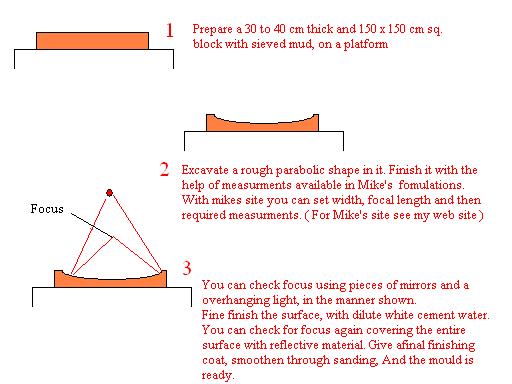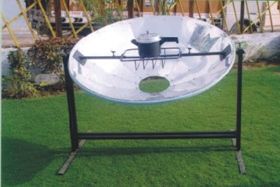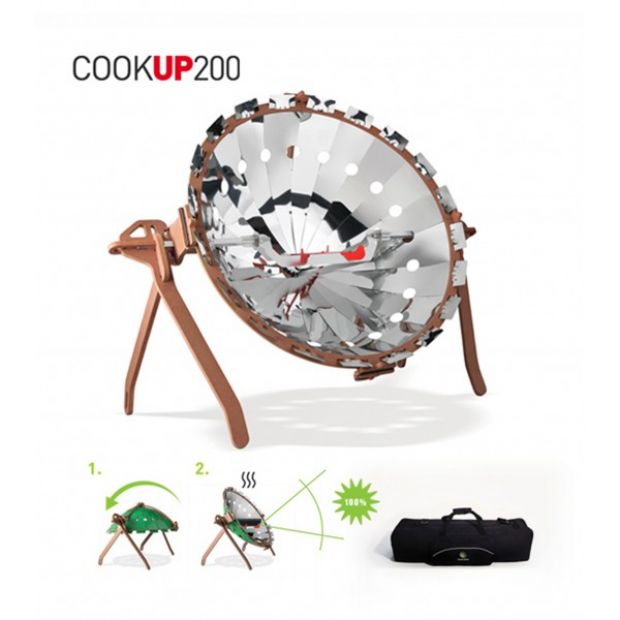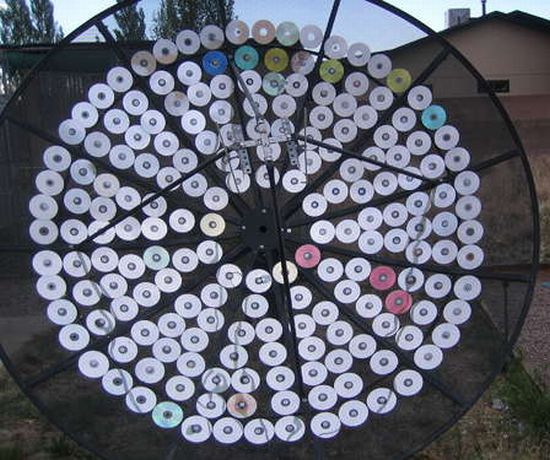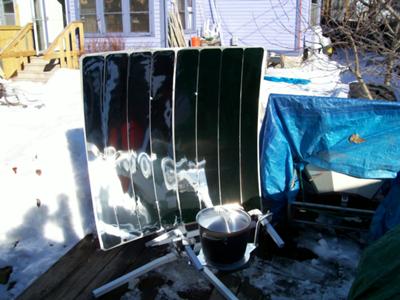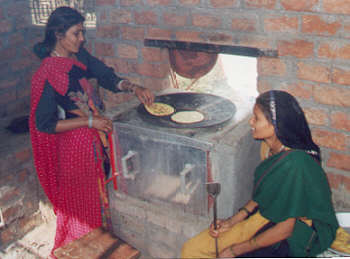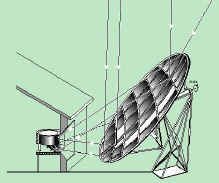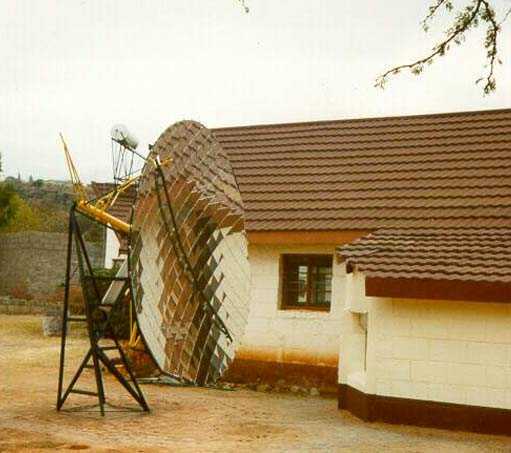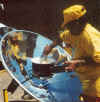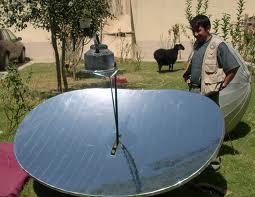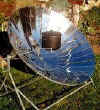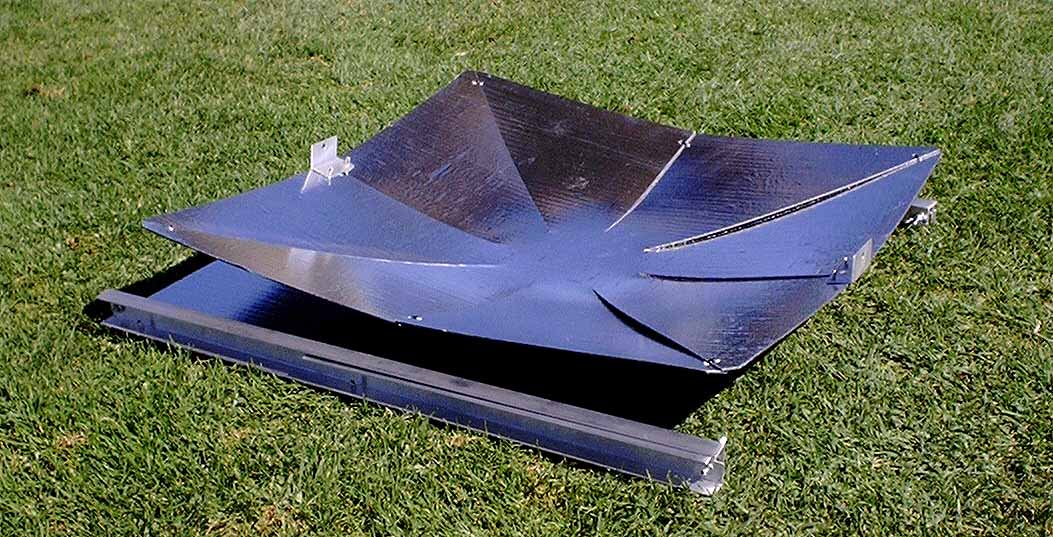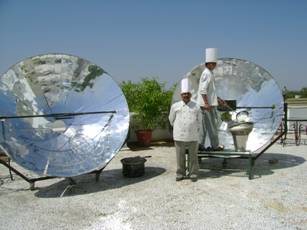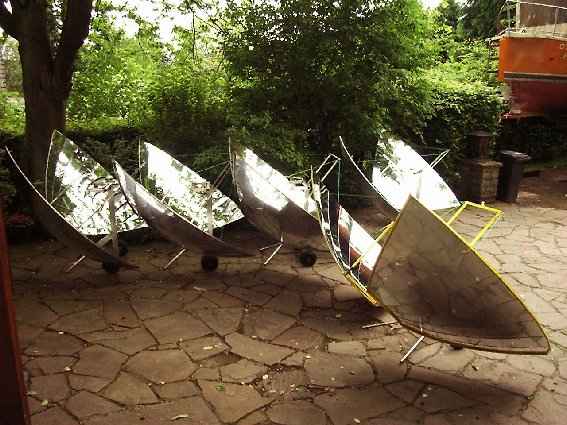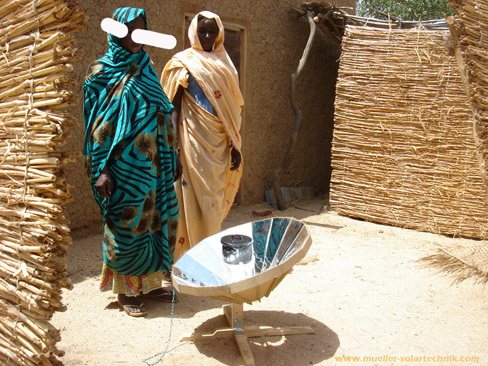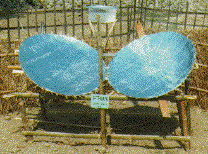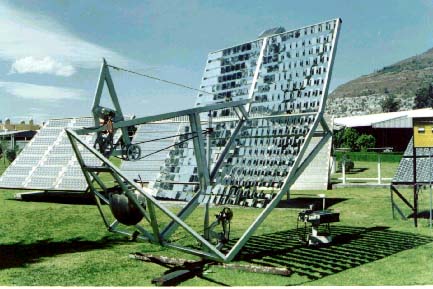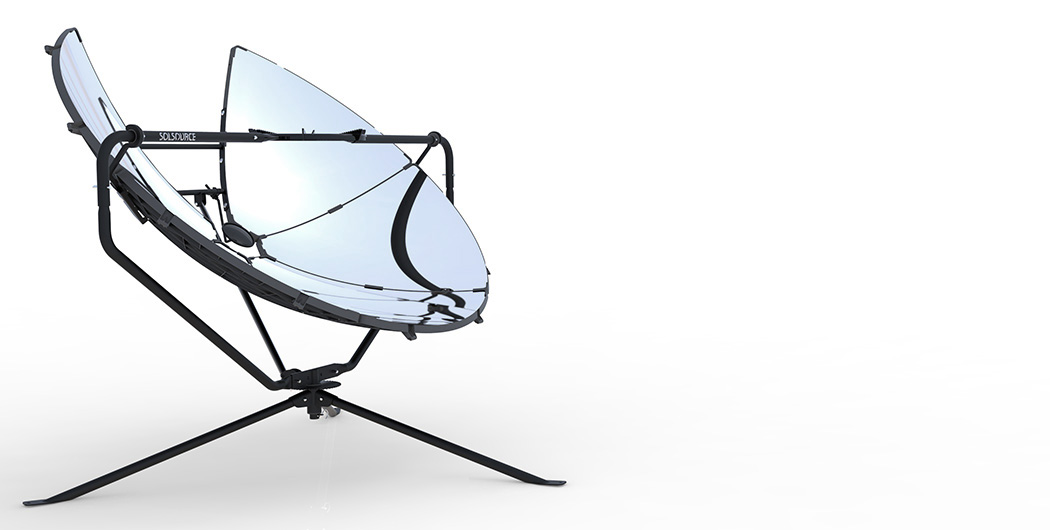|
Spherical Mirrors/Parabolic mirror/Rigid Parabola/Shallow Parabola/ Deep Parabola/Asymmetrical Parabola Being a pioneering design, this type of cooker has seen maximum variations, Besides, the design offers several advantages. One of the most important is that the mode of cooking is very much identical to day to day cooking. There are two major types of concentrator solar cookers: (I) cookers which concentrate the light from below, and (ii) cookers which concentrate the light from above. Heat coming from below is most convenient for routine cooking, hence, many designers have concentrated on this type of cookers. There are a lot of designs in this category, and they are classified on the basis of the type of reflectors used
(I) Spherical reflector (S), (ii) Parabolic reflectors (P), (iii) Fresnel types (F), (iv) Cylindro parabolic (CP), and
Spherical mirrors are the simplest type of reflectors, very easy to build and use. Focusssing is also easy, and if one opts for a moving vessel to meet the focus, cooking can also be done very easily. Such a design was suggested for the first time in the year 1961 by Stam (1961) (Type S1, Figure 1). He suggested a large reflector of 4.0 m diameter made of local material which could even include mud, and the reflector surface suitably smoothed with fine mud/cement and coated with aluminized polyester. An appropriate technology handbook describes a simple method of construction of the spherical mirror in the ground (a tall tripod with a long string to which a stone is attached at the tip, will act as a guide for excavating a hollow in the ground) and after finishing and stabilizing the interior, the reflector material could be stuck to make it into a spherical mirror. Such a mirror, of about 2.0 m in diameter, would do useful work for at least five to six hrs a day.
The cooking vessel could be hung from the tripod or a suitable stand and positioned to cooking vessel could be hung from the tripod or a suitable stand and positioned to meet the focus (Type S 1a). Dr. Halacy 91974) suggests a similar design (Type S 1b, Figure 2). He uses two full and several half cardboard ribs to fabricate the base with a mylar film as a reflector. This device was meant mainly for campers. Bamboo and/or other locally available materials could be used to fabricate such hemispherical baskets (Type S1).

Recently Prof.Quintone of UK has takenup this design and is trying to popularise it in places like Peru. In his beautifully designed site, he presents detailed instructions on design and use.
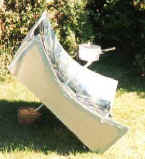
Unfortunately, this simple design has not attracted much attention, but on a very big scale, like in power generation (as in Marseilles France), such a hemispherical mirror is used (Jet Propulsion Laboratory 1981). Scientists of Australia (Anon. 1979) have presented a similar design.
Medved et al., propose an interesting design ( 1996 ) called as 'SOLAR BALL'. Designated here as Type S 2 . It is an inflatable plastic ball with lower part of reflective material. Cooking vessel is kept at the base. It is an interesting variation but there appears to be some serious limitations with reference to size of the Ball as well as size and handling of the cooking vessel.
Recently the sperical geometry has made a come back and we see that in India. At Auroville,such a mirror is built to cook meals for about 1000 persons. It is 15 meters in diameter and 7 meters above ground level. The sun's rays, trapped by a huge hemispherical mirror, focus on a cylindrical boiler which follows the sun's position by means of a computerised tracking device. On a clear day, sufficient steam at a temperature of 150°C can be generated in this boiler to cook two meals a day for 1,000 people.For further details a visit to their site is a must.( http://www.auroville.org/research/ren_energy/solar_bowl.htm) The figures presented here are from their site.
Fig.2a1. Sperical mirror and kitchen as constructed at Auroville, Pondichery, India
Most of the designers have thought about one full circles. I think half to one meter wide (2 or 3 feet wide) strips too should work well. Though parabola performs better, Hemisphere would be easier to construct and to operate as well. Parabolic ReflectorsParabolic geometry is well known, and it was probably the very first type of solar cooker. In this category, there are maximum variations. The reason for its popularity was the focus which was much better and sharper than that of other types of reflectors, but at the same time it was very sensitive to change in the position of the sun and hence the use of such reflectors meant constant tracking. Besides it was difficult too to fabricate.
Many visitors to this site wanted more information on construction of Parabola. But it is very essential to learn about the geometry of the parabola as well. There are many a reviews and guidelines to fabricate a parabola, but one of the prolific programmer mathematician Mr Mike Scirocco, from California, in fact recommends the paper presented in Solar Energy by Dr. M Srinivasan et.al.(1978) for the fabrication procedure. Mike has taken lot of trouble to convert the text into a web page. This is not all, - Mike has a small program which can give you a lot of dimensions on Parabola. You just have to enter the diameter and focus of parabola and you get a whole lot of data. Mike seems to have taken my suggestion seriously and is planning to add more data which would tell a interested person as to make a parabola from a flat sheet from which a parabola of desired focus and diameter are to be constructed.
Mike Scirocco is not new to this site, and also those who are trying to fabricate a parabolic reflector. A vist to his site is a must Mr. Mike Scirocco's site Mike has updated his already excellent program on the subject, it is a freeware, it is easy to use, makes the task of fabricating Parabola very easy.
But how to start with making one ? Here I present the proposal in three easy steps.
The mud block has to be made from roughly sieved mud, this will aid in finishing process. This can even be hand sieving by removing large stones and fiber particles. During drying process cracks appear, but yo need not bother.
Mikes program makes it easier to excavate a parabolic shape in the mud. You need to know the diameter of the reflector, and it is generally 120 to 140 cms. Larger the better. Then next parameter to select is the Focal length. Once these parameters are given the program gives you exact measurements in X and Y axis of parabola and thus it is easy to excavate the parabola.
TWO TYPES of parabolic reflectors are recognized in this review: (i) rigid parabolas, and (ii) collapsible or folding parabolas. Rigid parabolasUnder this category, three major types have been identified: (I) Shallow parabolas, where the focus is outside the rim of the reflector, (ii) Asymmetrical parabolas, which are partial parabolas, and (iii) Deep parabolas, where the focus is within the rim of the reflector (Chart I).
There are just two variations in this design. PRS 1 is probably the oldest design, it has a firm U-shaped stand which holds the cooking post as well as the reflector. It is on record that Mouchet built such a cooker for the French troops of Napoleon III. The popular model, however, is known as the Wisconsin design of 1959 (Type PRS 1a, Figure 3). In this design, the reflector has a plastic base on which mylar was stuck. The design was not stable in the wind and there was also some problem of spilling of cooking material while the reflector was adjusted, and, hence, several designers have tried to improve upon it. Types PRS 1b to 1f are basically similar but for some modifications in the stand, orientation mechanism or materials used for the reflector, etc. The WHO design, PRS If, was most the sophisticated in terms of design and materials used. The Chinese type has a reflector, which has a slightly different rectangular shape and is made by sticking small pieces of mirrors on to a parabolic base. The vessel is kept on a separate stand to avoid spilling. Test data was not available. A Wisconsin design with 1.0 m reflector could boil 1 liter of water in 10-20 minutes, provided the assembly was aimed at the sun every 15 minutes. Recently, Kumar (1994) has conducted technical analysis of the parabolic mirrors. A lot of difficulty was encountered in the fabrication of parabolic reflectors, even with thin sheets of steel, so, many have presented easier methods. Srinivasan (1979) proposes a method wherein a circular sheet was cut out into suitably shaped petals, dimensions of which are carefully arrived at after detailed calculations. The petals are then joined to form the parabola, But this method too was found rather difficult, especially cutting out ‘curved petals’ from the sheet. So, a simpler method has been proposed – (Concept I) – which involves cutting the circular (1-1½ m) GI sheet into ‘petals’ with straight cuts up to the border of a 15 cm inner circle. Before cutting, 5 mm holes are drilled at the junction of this inner circle and the line of straight cuts. This would assist in easier overlapping (Figure 4). Then, the ‘petals’ are fixed overlapping one another, only at the edge. The width of this overlap was calculated using standard formulae (Baumeister et al. 1978; Kundapur 1995). However, the best parabolas could be fabricated only with the help of large lathes. VITA (1961) recommends several simpler techniques such as: (i) soil-cement depressions in the ground, (ii) molded vermiculites, (iii) wire reinforced concrete shells, and (iv) paper-mache shells. The Boeing Company made hi-tech parabolas. Composite honeycomb structure was reinforced with fiberglass epoxy sandwich, to which a reflector material, polished aluminum sheet, was stuck. The reflector surface was further protected by vacuum deposited silicon oxide coating. It was reported that such a hi-tech reflector delivered about 437 W of power compared to 300 W of spun aluminum reflector of the same size. The size of the reflector is directly proportional to the performance of the cooker, and hence, it is a very important parameter. However, in most of the cases the size of the reflector was 1 sq. m only.
For Comments, suggestions,contributions contact Email : arkundapur@yahoo.com Please add, Solar or Solar Cooker, in the subject to avoid your mail being erased as scam
The Chinese type PRS 1g had an area of about 1 ½ sq. m and the design proposed by Kulkarni (1978). PRS 1h, had an area of about 2 sq. m, this design also incorporates a cradle, enclosed suitably with a windshield, to hold the cooking vessel (Figure 5). Kulkarni reports that even chapatis could be fried in this cooker. This design was being marketed by M/s Jyothi Industries of Baroda. Another design with a 2 sq. m reflector was that of Walton et al. (1977). It is also known as Volta type (PRS 1e). Prof. Ghai’s (Anon. 1970) parabolic concentrator was of a different type (PRS2, Figure 6). Evolved in the 1950s, the reflector was made from spun Aluminium sheet. It had a hole at the centre through which projected an arm of the stand to hold the cooking vessel. Part of the reflector was cut out to enable easy access to the vessel. The entire unit had to be turned to face the sun.
These types of cookers did not become very popular, but The German News, 38 (June-July): 5-6, 1997, informs that 180 sq. m, parabolic concentrators have been installed at an institute at Mount Abu, to generate 600 kg. of steam at 16 bar pressure and cook food for 1200 people (Herms 1977).
Fig 3a. Parabolic Mirror array form Mt. Abu ( Source SCI site )
Recently Sintex Plastics of India seems to have entered the Solar Market in a big way. They had been manufacturing Solar Water Heaters of Plastic, but now they are trying their hand at Solar Cookers, the Parabolic as well as Box type Cookers. I am yet to receive the samples for evaluation. The photo presented here has been copied from their site, though it does not display any innovations, the price is very competitive at just Rs. 2500. Of course, much depends on the reflective coating too, and again I am yet to receive details regarding the same. With a long lasting Reflective material, and at the price, this Parabolic Cooker should steel the market.
Another recent addition to the family of Parabolic cooker comes from the prolific inventor Mr Deris of California. The Parabola it self is simple, he seems to have discarded the interesting design of square Parabola invented by himself. The parabola he uses is held vertically, and it directs the focused rays on to a Cooking vessel kept on a reflector kept horizontally on the ground.
Recently many new and beautiful designs have appeared on the scene, and I am only showing some outstanding designs. But as I have not tested them or have any detailed information about it, I can not assure the reader about their performance or durability.
Cheng-Tsung Feng 's Design, Taiwan, Remarkable design indeed, Specially designed for people trapped in disaster areas. Spcial pakage contains 2 such cookers, vessels and food to last for 7 days for two members. Remarkable indeed.
Another beautiful design from Europe
This design was made by a student with old Compact discs.
This cooker comes with a motor to rotate the cooking vessel. The design is from America
Interestingly way back in 1980, I had proposed that a reflector/focusing device kept outside or in a suitable position would point focus the image in the house which could then be used for cooking. This design you would see under Type ---but such a concept has already taken shape, independently at Bahai institute in India and with the help of a parabolic reflector kept out side the hut cooking even Chapathis are being cooked.
Fig 3a1 & 2 Photos from Bahai Institute, India ( Ref. their site on the web )
The following diagram shows the principle of Scheffler's reflective cooker design in detail.
The photos bellow shows Scheffler's reflective cooker, a 2.7 m dia cooker, just out side an Indian Home, The photos are from ecosolar.com. The second photo shows a lady cooking in a small kitchen.
The parabolic cookers are
being uses extensively in Africa as well, and the photo below confirms it
further.
Attempt are on worldwide to form parabolas from other materials. In India it is being made from mud. The photo included, taken form Solarcooking.org site, confirms this. The mud base is then lined by reflective material.
A recent design is of interest, dubbed as Cantenery Solar cooker, it has been designed by Jack Turzillo, Junior at Tigard High School, Poertland, USA. Mr Jack has done some meticulous calculations using computer programs. According to him construction of Cantenery design is easy, the curve being close to that of Parabola.
Cantenery Parabola Many interesting variations have been reported, and some of the following photos, taken from Solar cooking.org, are self explanatory.
This Squar shaped parabola is indeed a novel design by Deris of USA, because metal sheet come as rectangle or square shape, squar. parabola would be the best thing to think of to minimize wastage. ( Ref. solracooking.org site )
Prof Ajay Chandak of India has come out with another variation of Square parabola. Here he has used strips of reflector material rather than converting the entire sheet as done by Derris. Ajay report that the results are better than that of regular parabola.
Mr Veljibhai Desai of Tinitech, of Rajkot (+919227606570, tinytech@tinytechindia.com, http://www.tinytechindia.com) is manufacturing large designs of this type of square parabola capable of cooking 5 kg (+14 kg of water so a total of 19 kg) of rice per batch,within 60 min. The unit is foldable and can be easily stored. He uses German made Aluminium Reflector strips. Tinytech is manufacturing many more alternate energy devices, a visit to their site is a must.
Tinytech's Community Cooker
'Old is gold' it is claimed and this has been proved once again by Prof Ajay Chandak of India. In what could be considered as worlds biggest project Prof. Ajay has installed 363 Parabolic community cookers in tribal schools. Each reflector has a diameter of 2.3 meters. Fixed on to a rigid 'A' type stand, the cooker can take care of 22 lit pressure cooker and can also be used for wide variety of cooking. These cookers are installed in tribal schools located in remote areas of Maharashtra(India). Each cooker cost around Rs 26,000/- (US $575)and is supplied with large Pressure cooker, sun glasses, gloves etc. The picture bellow shows such a cooker being used at a Hotel. Note the small platform for the cook to stand on. The Cook can use an umbrella tied to a stand. Prof Ajay selected Parabolic cooker, because Scheffler's cookers involved more cumbersome technique to fabricate and required a costly installing and tracking mechanism, making it rather expensive. Author congratulates Prof Ajay on the excellent work done by him along with his team.
Another interesting variation has been designed by active workers from Nepal, by Sri Ram Ashis Sharma and Hannu Virtanen. Other details were not available at the time of uploading this details. ( Ref. solracooking.org site )
A new and interesting design of Parabolic Cooker has been presented by a German Group. It is called 'Papillon', for it looks like a Butter fly with wings open. Though a Parabolic Cooker I would classify the same under Duel Parabola which has been in vogue in China and Nepal. But Papillon could be considered as an improved version over that of Nepal Design, if the claims made by the designer are certified by an independent group. I find it very attractive and have a feeling that it would be as efficient as it is claimed. But am not sure about wind stability. I feel it can be improved by widening the base. Each wing like reflector measurers One meter square, so together it make it a Two Sq. meter reflector delivering 1.2 Kw . The Designer group, BSW Alternative Energie, has listed a lot of features and data on the cooker and a visit to their site(www.bsw-energie.de ) is a must. It would be better if the design can be made in such a way that it can be assembled only with nut-bolts ( without brazing,) and other activities like forming a Parabola at the site. Without any doubt the efficiency could be improved by 'enclosing' the cooking vessels. I am expecting further details from BSW as well as any test reports from Solarcooking International or Dr Paul Funk.
Recently Zhu and Kim have evolved a parabolic Cooker which they claim as non tracking. May be the geometry is such that it may not require constant tracking. In which case, it would be more of a deep parabola as would be detailed later. The Photo is from Solar cooking archives.
Mr Bernhard Muller of Germany (http://www.mueller-solartechnik.com)has comeout with a low cost design of Parabolic cooker which is dubbed as "Kundu Kar". This design is being successfully used in Africa.
Kundu Kar of Muller.
Prof. Von Oppen (1977), working in India, proposed a do-it-yourself deep parabola (PRD 1). The focus of the reflector was inside the rim of the mirror, almost at the base. This design was unique in several respects. It made use of locally available materials like bamboo, paper pulp, Aluminium foil for the reflector, and a unique and simple method for tracking the sun.
The method
of fabrication of cooker was
simple, a master mould was made to form the shape of the deep
parabola, paper mache was smeared and dried, fine paper pulp was
used to make the interior smooth, and this shell was reinforced
with bamboo from outside. The interior of the shell was then
coated with Aluminium foil. The cooking vessel was hung from a
string (Figure 7). Focusing was essential only once in 30
minutes. Provision was made for automatic tracking.
Tracking system comprised of a pipe of about 15cm diameter and 1 m height, it was buried upright near the basket and filled with water. A bottle, half filled with water, was hung on into this pipe with the help of a string, and the other end of the string was tied to the basket. A small hole at the bottom of this pipe let out water and as the water level went down, the half-filled bottle sank, turning the basket suitably. However, effective cooking power was estimated to be only 250W. Initially, the cooker created a sensation. There were many difficulties in using the cooker, it was difficult to handle the hot cooking vessel, and the basket was not stable in strong wind (GATE 1979).
In 1979, the German Appropriate Technology Group (GATE ) proposed another less deeper parabola (PRD2, Figure 8). The reflector was 1.4 sq. m and was supported on a firm stand. The cooking vessel was to be hung from a separate stand (GATE 1979). Kapur (1982) described a similar design with further improvements in the stand like adding castor wheels (Figure 9).
For Comments, suggestions, contributions contact Emai : arkundapur@yahoo.com Please add, Solar or Solar Cooker, in the subject to avoid your mail being erased as scam
Another interesting design from Nepal uses two parabolic mirrors, made of various materials including clay and coated with probably with Aluminised polyester. ( For details see SCI site )
Mr Hannu Verten and his team is doing excellent work at Nepal and his site is worth visiting for excellent photos, plans and comments.( listed under Links of Solar 16 ) The Classical Chinese design presented here bellow is one such example.
Asymmetrical parabolas
An Asymmetrical parabolic reflector enables a cook to be as close as possible to the cooking vessel. In fact, in some of the earlier designs, like in case of Ghai’s design (Type PRS 2 and also in PRD 2), part of the reflector was cut out to facilitate this. But Tabor (1966) proposed a unique design (PRA 1). He used several smaller parabolic mirrors and arranged them in an asymmetrical parabolic configuration (Figure 10). The unit has a ‘U’ frame rotating on a pivot fixed to a strong base.
Tabor's design seems to have made a comeback. Recently the Solar Cooker group from Mexico have devised a bigger version of this type of cooker. The device is equipped with a tracking unit also
The frame has a stand in the middle for cooking vessel. Focal length of the reflector was 83 cm and the area was 0.8 sq. m. A temperature of 300o C could be attained though the effective cooking power was estimated to be 185 W, which appears to be a low estimate for me.
A Chinese design first described by Fang, Susan (1979) was indeed classic in many respects (Type PRA 2, Figure 11). The concentrator could be easily oriented, as there was easy access to the cooking pot, which rests on a firm stand, stand was sturdy. The reflector had an aperture of almost 2 sq. m. Designers claim that it delivered 560 W of power, rather a high figure when compared to any other type of cooker. A prototype built here at Udupi performed satisfactorily. It is unfortunate that no one remembers this excellent design.
For Comments, suggestions, contributions contact Emai : arkundapur@yahoo.com Please add, Solar or Solar Cooker, in the subject to avoid your mail being erased as scam
Concept II, PRA 2a, suggested by me, envisages the use of strips of reflector. This would make the fabrication easy and may perhaps increase the efficiency and maintenance of the reflector as well. Further, an transparent insulating cover around the cooking vessel would increase the efficiency and would add aesthetic value.
Patel (1982), working independently, had evolved another design which he calls Suryakund (Indian Patent 233/234, Bombay – 80, and No 100/Bombay/81). This design has a deep asymmetric parabola without a point focus (Figure 12). The cooking vessel located inside a glass chamber at the focal point is easy to handle. But the focus would be a ring focus rather than a point focus. Designed with mass production in mind the reflector was moulded with ABS plastic to which aluminized polyester was stuck. The whole assembly can be easily rotated even with the cooking vessel to track the sun and all this makes this a novel design. However, the size of aperture is rather small and can be of use to campers or to people who wish to warm their food.
Interestingly, several designers have arrived at this interesting design, some of which have been branded by them as Panel cookers, so you will find these designs under panel cookers or Conical cookers.
For those who wish to cook from inside the house, or at least near the place where such shapes are used to trap radio waves,) Murthy (1982) presented an interesting variation designated here as PRA 4 (Figure 13). The device is a large asymmetrical parabola of Auminium sheet hooked on to a strong stand which can rest on a window frame (a provision had been made to adjust for the declination angle of the sun window.). The author calls it an offset feed parabola, a by-product of space technology (Figure 13). The author claims that the design delivered 994 W, which appears rather high ( the reflector used was only an Aluminium sheet). Later, Murthy suggested that such a device could be fixed on to south facing window for better results. An insulated cover around the cooking vessel would increase efficiency. The design should incorporate easy folding facility such that it could be shifted easily from one window to another.
Prof Ajay, is a prolific designer based at Dhule, Maharastra, India. His design called as Balcony Cooker is presented here, I classify it as PRA4a as it is very close to Murthy’s concept. The Balcony Cooker must have been evolved independently by Ajay. Ajay’s another design called Hybrid cooker is presented on the next page under plane mirror section, almost at the end of the page.
Scot Frank and his group have evolved one of the best designs of Parabolic Solar cooker. Dubbed as 'Solsource Solar Cooker' it has been evolved in close proximity of end users. I had the privilege of of operating it personally and I am very satisfied. It comes in a small packet and can be assembled by the users. The reflector is very good and in accelerated tests it has been found to last for over 10 years. A small convex black 'reflector' placed at the bottom of mirror, helps in focussing the sun at the base of cooking vessel. The cooking vessel is to be kept on the grill attached to the stand, letting the reflector free for easy orientation. This design is the best I have seen and used in Parabolic cooker category. For more details you may please visit http://www.oneearthdesigns.com/, and also http://www.cleancookstoves.org/blog/partner-spotlight-one-earth-designs.html
NAVIGATION CHART.
OTHER LINKS
are listed
under S11-References A to W
For details
regarding testing standards for Solar Cookers ( International
Standards ) please
click here
For Comments,
suggestions, contributions contact
Dr.
Ashok Kundapur
Email :
Please add Solar or Solar Cooker in the subject to avoid your
mail being erased as spam
|
For
details regarding testing standards for Solar Cookers ( International
Standards ) please
click here
For Comments,
suggestions, contributions contact
Dr.
Ashok Kundapur
Email :
Please add Solar
or Solar Cooker in the subject to avoid your mail being erased as
spam



